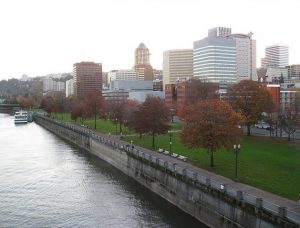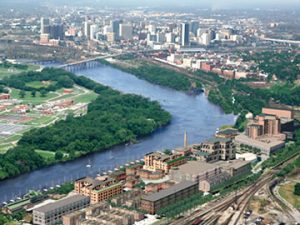I never took Latin as a child, I took Spanish. So the first time Dr. Lookingbill used the words “Riparian Zones” I had no idea what he was talking about. For a few minutes I was completely dumbfounded about this new topic I had no prior knowledge for. I had no idea how important they are to the health of the water shed. I had no idea how much a place can be defined by what happened historically in that riparian zone. Now halfway through the semester I know that the word “riparian” is from the Latin word “ripa” which means river bank. Now I realize the great importance of the riparian zones and how they are the core of the health of the river. Now I know that it is important to focus on improving the health of the riparian zone to improve the well being of the entire river. The James River Association has three main components they focus on to improve water shed quality. This organize has decided to put all of their time and money into only three things; storm water runoff, invasive species removal and riparian zones. This focus shows how important this one place is for the healthy of the entire river. Although I did not know much about them at the start of the semester, I know understand just how important riparian zones actually are.
At their core, healthy riparian zones help protect and stabilize aquatic habitats. The roots of the trees in these zones help hold in the soil and stabilize river banks. This prevents erosion and reduces the sentiment entering the water. Leaf canopy also acts as a natural umbrella, shading the river and cooling it down. The presence of shade spots and some sun spots are advantageous for fish populations, due to ectotherms wanting to change their metabolism rate based on current conditions. Now they can move freely to different temperatures. Another benefit of riparian zones is that the the soil helps filter the water entering the stream. Through both groundwater and overland flow, the water is slowed down and detrimental compounds are filtered out. Flash flooding is also reduced as the water is slowed down an time between rainfall and peak water levels is increased. The importance of riparian zones for controlling erosion has been recognized with studies from the HJ Andrews experimental forest we visited, where now loggers are no longer allowed to cut trees to the edge of streams and must leave a buffer to not destroy the river’s delicate natural processes.
Riparian zones are also important hotspots of terrestrial biodiversity. A wide range of flora and fauna inhabit riparian zones. Many different tree species are found only in riparian zones and nowhere else. Some examples of these which can be found on campus are the Black Willow, River Birch and Sycamore trees. Everyone in this class should be already familiar with identifying these species, but I hope that we as students can understand their importance of contributing to riparian zones. Macro fauna like birds and mammals use these long corridors as safety highways, protected from predators and always having close access to food. Without riparian zones a wide range of an important species will suffer.
Ann Woodlief tells us repeatedly how these riparian zones are almost a historical oasis in her book In River Time. Humans have always been attracted to live near riparian zones since early history. Along the James river, the Native Americans were the first to make use of this rich resource. They were drawn to the high concentration of wildlife, and plant based foods as well as the more moderate temperatures. European settlers were also attracted to building cities in riparian zones, but this time with the access to trade routes as a primary concern. With most of early human history occurring in riparian zones, it truly is important to realize the historical significance of these special places.
Downtown Richmond’s riparian zones directly contrast those I found in downtown Portland on our class trip. Richmond’s downtown is mostly characterized by the James River Parks system that controls the land next to the river. This land is kept natural and is made into public parks with very little artificial banks. While reading Portlandness, I was struck with how environmentally conscious Portland was as a city. It initially appeared to me that this was a city that knew what was needed to protect their own watershed. They knew what was the best for the environment and implemented those plans. A perfect model for others to follow. This view was shattered when we visited Portland and I was able to see their hard river flow control. There was a total lack of riparian zones and abundance channel bank infrastructure wherever I looked. The discarding of riparian zones and creation of artificial banks can have negative long term consequences for their entire region. This changed my view of Portland as a city from an romanticized phantom of perfection to something much more pessimistic.
There are countless downsides to the approach that Portland took to develop their river banks. The largest and most noticeable is the concept of hydrologic drought. Michael describes hydrologic drought by declaring that the end result of the process is “a huge portion of the invaluable function played by riparian zones as buffer systems is lost”. This process is fairly complex, but starts with the lowering of the water table. The hard concrete banks do not allow as much water from the steam to enter the groundwater. These initially saturated soils then go through a major ecological reversal event. As the water leaves, oxygen freely flows in. This completely changes what microorganisms live in the soil, as anaerobic organisms cannot function in these new aerobic conditions. The result of this is the nitrogen fixation previously occurring is stopped, and instead an increase of nitrogen is given back to the atmosphere, instead of being processed into natural compounds. This is a significant imbalance and the quick change can increase algal blooms and even create dead zones in the water, where the algae uses up all the oxygen present. Native fishes cannot live in this low oxygen environment and die away. Not only do hard banks in Portland create negative effects, but natural banks have their own category of positive effects. Natural banks with dynamic small scale erosion are hotspots of bio diversity. Each and every scale of organism from large mammals to small bacteria can find a place to live on the bank. Hard concrete banks do not allow for this wide range of habitat. That sediment from small scale erosion then flows downstream, and creates habitats for different organisms. The changing nature of erosion also modulates the flow of the river, and allows it to move freely within larger boundaries. All of these benefits are essential to the health of the river, and it is hard to see how Portland can call itself a green city when lacking all of these normal biological processes.
Focusing on improving urban riparian zones are the best way to improve the health of any river. Urban regions are where most of the pollution enters a river and many cities lack riparian zones to help filter it out. Riparian zones not only improve the health of the organisms in the river as well as on land. They are truly a valuable resource with immense ecological value. Richmond as a city seems to be doing well on maintaining its healthy natural banks that form its riparian zone. On the other hand, Portland seems to not care about the health of their water shed, because they build hard artificial banks to define the river’s boundaries. Banks like these will have long term negative effects on society, that will end up costing more to fix than if then if the city left bank natural. Riparian zones form the foundation of any ecosystem, and protecting them is of the upmost importance.



